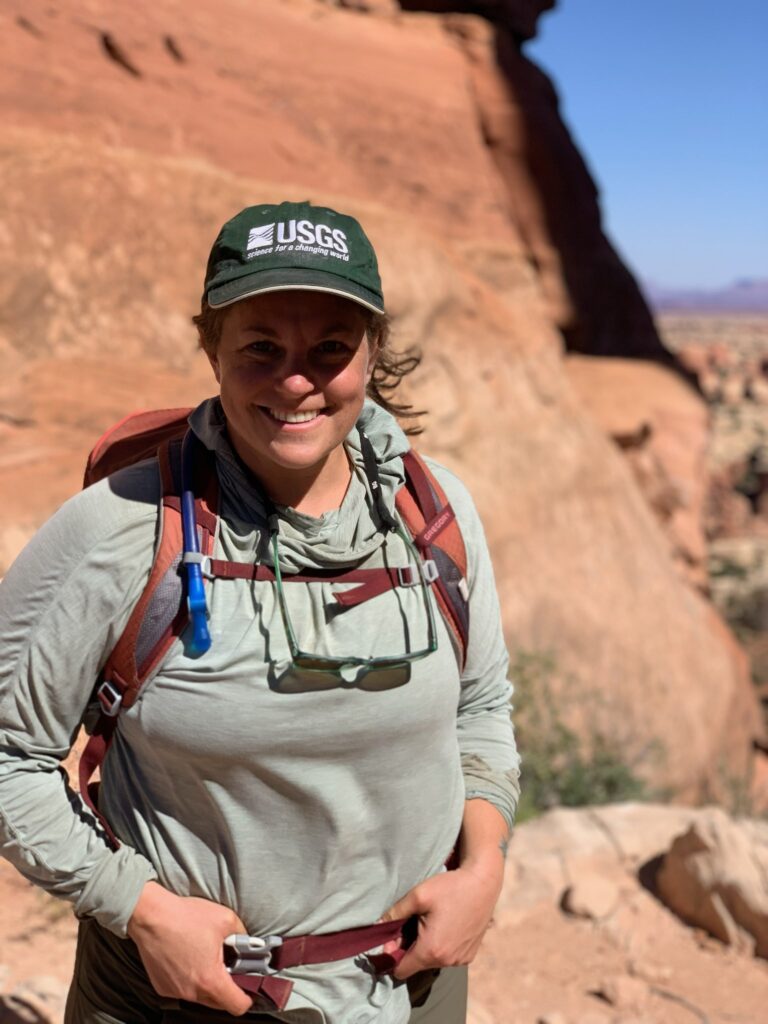Some information may be outdated.
Science Moab talks with ecologist Rebecca Finger-Higgins

In summer 2021, a campfire at the Pack Creek picnic area sparked a wildfire. Today, scientists are studying how the landscape—previously a swath of pinyon and juniper stands—is recovering from the fire. Rebecca Finger-Higgins is one of those scientists: she’s an ecologist whose research in dryland ecosystems has taken her from the tundras of Greenland to the deserts of Southeast Utah. Recently, she and a local team were awarded funding from the Canyonlands Natural History Association to study fire recovery in the Pack Creek area.
Science Moab chatted with her about her work as an ecologist with the Southwest Biological Science Center (part of the U.S. Geological Survey) and the project.
Science Moab: How did this project start?
Finger-Higgens: The Pack Creek fire broke out in early June of 2021. In total, the fire burned just shy of 9000 acres. I definitely felt a vibe throughout the whole community that there was kind of this mourning and this real sadness with the Pack Creek Fire. Moab is actually this beautiful science hub, where we have some federal agencies, we have Utah State University, and then awesome nonprofits like Rim To Rim Restoration. So, a bunch of us got together from the USGS as well as the U.S. Forest Service and partnerships with people with the BLM as well, and we just wanted to know, what can we learn from this fire?
Science Moab: You’re looking at the pinyon/juniper recovery. In an ideal world, what would be the response of a pinyon/juniper forest following a catastrophic fire?
Finger-Higgens: We do have some colleagues and other researchers at the USGS led by Sasha Reed who have been working with a team out of Mesa Verde, where they’ve been tracking a series of pinyon juniper fires. There is not a lot of recruitment that usually comes after these fires. Ponderosa pines and other alpine systems regenerate pretty well after fire, but we don’t necessarily see that in pinyon/juniper systems.
There’s also some concern throughout the Southwest that climate change might be shifting what we’d call a climatic envelope. The perfect environment that pinyon/juniper forests need to thrive may be shifting due to higher temperatures and drier environments, which would make pinyon/juniper recruitment all that much harder.
Science Moab: What data are you looking for to assess the recovery of these forests?
Finger-Higgens: Right now, it’s really the small plants that are coming back that we’re thinking about more than the trees. It’s only been two years, which is not enough time to see even the seedlings [of trees], they’re so itty bitty at this point. So a lot of the project working with the CNHA has focused on these smaller flowering plants, some of the shrubs and what we’d call early successional species.
We’ve seen that things that can grow quickly are moving in—grasses and flowers and small shrubs. After the fire, there was also immediate action on the part of the Forest Service and Rim to Rim Restoration in the seeding of wildflower species. Part of our study was designed to see how effective that seed mix was. When we went back this year, we were collecting data on what plants were there, what was the estimate of their total makeup on the ground, and whether or not we saw a difference between plots that had this seed mix placed on it and those that had not.
Science Moab: What is the status of the project now ?
Finger-Higgens: It’s definitely an ongoing project. Fire recovery is never a quick thing. One part of the project that was funded by CNHA, was looking at the efficacy of this seed mix that was bought by the Forest Service. So that data was collected this year in June. We were getting an idea of what plants emerge, what’s their kind of average cover, how stable are the soils, and then taking pictures, and then that will ultimately be worked up, made available to the Forest Service, then ideally, put in a scientific publication.
I’m also working with Dr. Brooke Osbourne, who’s faculty at Utah State University, and she’s using that data in some of her curriculum as a teaching module and an example of the complexities of natural resource management. The seeding that was done by the Forest Service, a bulk of that was placed by volunteers. So it was community members that cared about this forest that were mourning the loss of the forest and wanted to help give back.
That was something that I think was really special to the Moab community and really incentivized me to do research here. It’s right in our backyard. It’s where we go in the summer to escape the heat, where we go in the winter to play in the snow. The La Sals are literally our lifeline of water and recreation and all kinds of things. It’s been really interesting to be a part of this.
Science Moab is a nonprofit dedicated to engaging community members and visitors with the science happening in Southeast Utah and the Colorado Plateau. To learn more and listen to the rest of this interview, visit www.sciencemoab.org/radio.
Appreciate the coverage? Help keep local news alive.
Chip in to support the Moab Sun News.





